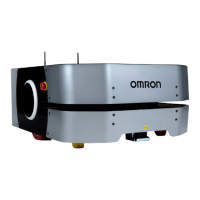Chapter 6: Connectivity
Figure 6-5 Sample Light Pole Diagram
Callout Description Callout Description
A Standard Equipment D Typical User Load
B Wiring Terminal Block E Equivalent Circuit
C User-Supplied Equipment
User Interface (Brake and E-Stop)
The LD-250 Core's User Interface Mini-Fit
®
2 x 7 connector provides circuits for the Brake
release, ON, OFF, and E-Stop buttons.
Pin No. Designation Notes
1, 2, 3 FBAT_ALWAYS Fused VBAT @ 500 mA
4 E-STOP_USR_1L Short 4 & 11 to close E-STOP_USR_1
5 E-STOP_USR_2L Short 5 & 12 to close E-STOP_USR_2
6 E-STOP_OUT_1L Pins 6 & 13 short when E-STOP_CH1 is closed
7 E-STOP_OUT_2L Pins 7 & 14 short when E-STOP_CH2 is closed
8 OFF_BUTTON Short to FBAT_ALWAYS to signal OFF (min 1 s pulse)
9 START_BUTTON Short to FBAT_ALWAYS to signal ON (min 1 s pulse)
10 MOTOR_BRAKE Short to FBAT_ALWAYS for manual brake release
11 E-STOP_USR_1H Short 4 & 11 to close E-STOP_USR_1
12 E-STOP_USR_2H Short 5 & 12 to close E-STOP_USR_2
13 E-STOP_OUT_1H Pins 6 & 13 short when E-STOP_CH1 is closed
14 E-STOP_OUT_2H Pins 7 & 14 short when E-STOP_CH2 is closed
NOTE: You can attach an optional, user-supplied, E-Stop button to the E-STOP
port on the User Interfaceconnector.
E-Stop Operational Considerations
Engaging the E-Stop through the external connector (or Operator Panel) faster than 250 ms
causes the drive motors to re-engage when you release the E-Stop.
Motor re-engagement occurs because the LD-250 Core is designed to receive a consistent E-
Stop signal for at least 250 ms. Signals that engage and disengage in under 250 ms cause the
LD-250 Core to interpret the signal as a bumper press, which automatically re-engages the
motors.
No signal on the E-Stop chain can cause the robot to operate while the E-Stop remains
engaged. Thus. you must keep the E-Stop engaged, if your intent is to keep the AMR in an E-
Stop state.
WARNING: PERSONALINJURYORPROPERTYDAMAGERISK
If you are using a user-supplied E-Stop, you must run the Safety
20472-000 Rev B LD-250 Platform User's Guide 103

